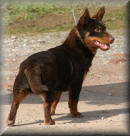|
Micro-Chipping
The benefits of micro-chipping Lancashire Heelers.
Apart from the rather obvious reasons for micro-chipping, reuniting lost dogs with their owners and helping to identify and recover stolen dogs, the micro-chip also serves a great purpose in our breed as a permanent identification method.
I will use our own system as a way to explain.
When our puppies are around 6 weeks old and before any paperwork is completed, we chip each puppy. They henceforth identifiable as individuals.
The puppies are taken to be eye tested for COLLIE EYE ANOMALY at around 7 weeks, the pups are scanned and each result is written alongside each pups unique micro-chip number.
The puppies are then registered with the Kennel Club and the registration papers come back not only with their name on but with their micro-chip number as well. When a buyer then comes to collect his/her puppy and are shown the eye test result they can see instantly which result is for their puppy. We have our own scanner to read the micro-chip numbers and identification is both positive and immediate.
If there is only one CEA clear in a litter of lets say 4 males, what is to stop an unscrupulous breeder from telling all 4 new owners that their puppy is the one with the clear result if they aren't micro-chipped???
Also, with the problem of Lens Luxation, if a dog changes hands a couple of times and the registration papers are lost, how will we identify its parentage if it tests as being PLL Affected if it isn't micro-chipped.
It is also a good cover for the breeder, as no one can accuse him/her of being nothing but truthful with puppy results.
We micro-chip every puppy born at Doddsline/Hotpot and feel everyone who breeds should be doing so. We hope that it will eventually become a legal requirement.
WHAT IS MICROCHIPPING?
Microchipping has been in use since 1989 and is the best way to permanently identify a dog.
The chip itself is no bigger than a small grain of rice. To prevent the body rejecting the chip it, is cased in a biocompatible glass, the same as that used in the human pacemaker
The microchip is inserted through the loose skin at the back of the neck by way of a tool rather like an earpearcing gun. It is quick easy and although a little discomfort may be felt is usually pain free
Each chip has its own unique number. Once implanted, the implanter records the number, his details and the new owners name and address on a sheet which is then sent to be recorded on a national database. The new owner will receive a certificate via post about a week later to tell them that the dog has been registered on the database and there will also be an address for the new owner to send off to so they can register a change of address if they move home.
A microchip should last for a dogs lifetime and is a very inexpensive way of permanently identifying your dog or a breeders stock.
Kay Critchlow
|

